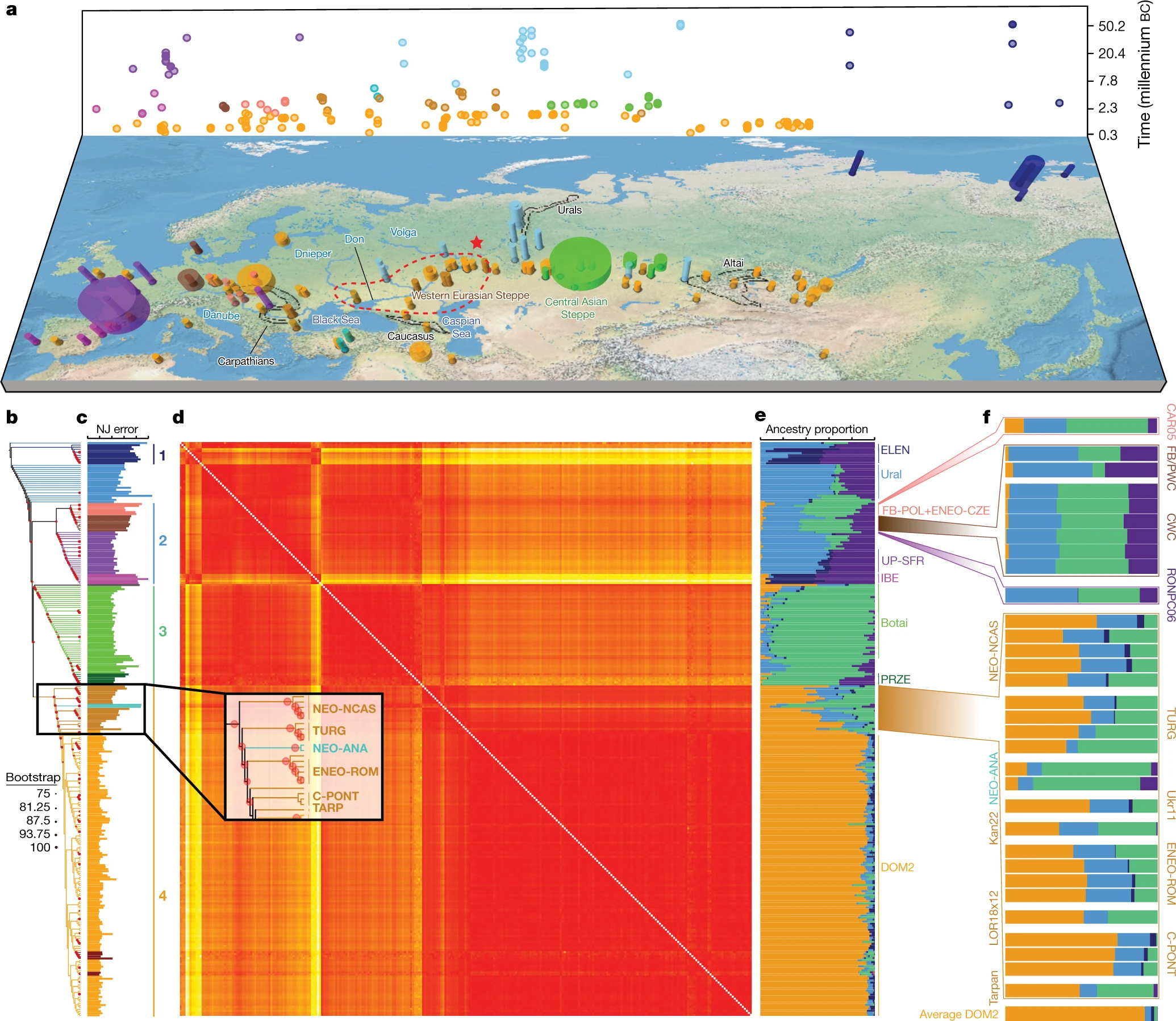I've been waiting for some concrete DNA evidence about where modern horses came from since I interviewed Alan Outram three years ago and he hinted that it was soon to be published. He indicated that Sintashta horses might end up being more important than Yamnaya ones, and now that the new paper, to which he contributed, has finally been published, I can see why.
Botai may have been first to corral horses for milking but they didn't ride them.
Yamnaya kept horses for milking too but we cannot see if they were ridden (However Trautmann et al 2023 shows Yamnaya did ride them)
Wilkin et al (2021) looking at milk proteins in pottery agrees with this new paper regarding "a potential epicentre for horse domestication in the Pontic–Caspian steppe by the third millennium BC" = Yamnaya.
Librado et al (2021) points to Volga-Don region (aka Yamnaya EUROPE) as the homeland of modern domestic horses
Sintashta horses (DOM2) were superior for riding (stronger backs) and replaced earlier ones from 2200 BC
Sintashta horses (DOM2) had genetic continuity with earlier Yamnaya /Repin ones (TURG) and Steppe Maykop (Aygurskii), and Poltavka (Sosnovka) - specifically two late Yamnaya specimens from approximately 2900 to 2600 BC
Yamnaya horses had some relation, but not much, to Botai horses
The Tarpan and modern Przewalski’s horses do not descend from the same ancestral population as modern domestic horses
Modern horses were domesticated in Europe but the paper calls it West Eurasia - possibly as a deliberate, politically motivated obfuscation
The ancestors of Sintashta horses came from the steppe East of the Dnieper and West of the Volga-Don region - ie: firmly within European Yamnaya territory during the late fourth and early third millennia BC
Corded Ware horses were not the same as Yamnaya/Sintashta horses
Earlier LBK and other Neolithic horses in Denmark, Poland, Czechia and Hungary had some affinity with Yamnaya/Sintashta horses - the geneflow seems to have been via Thrace
Corded Ware expansion into Europe was not accompanied by horses but rather they adopted local horses as they migrated (not clear if they were ridden)
Replacement of other horse lineages in Europe and Asia by Sintashta ones was accompanied by spread of both equestrianism and (a bit later) light two wheeled war chariots
The spread of Sintashta horses into the middle east was likely accompanied by the spread of a specialised class of Sintashta descended horse trainers like the Mitanni.





Good work my friend.
ReplyDeleteMost articles i read stated that the domesticated horse came from the volga Don region in the Caspian steppe. so it can't be the yamnaya culture because it didn't existed at this time or sintashta culture wich is in the Ural further east. the Catacomb culture(they are R1b) wich comes directly from yamnaya domesticated the horse, not sintashta. and this horse spread first into Europe before it spread to Asia. it's surprising that you are ignoring the Catacomb culture, because you claimed that mycenaeans came from the catacomb culture. so why ignoring them now? I think you are bit mistaken. correct me if I'm mistaken too please.
ReplyDeleteI was thinking about making a post regarding this article and the other one regarding domestication but you beat me to it and covered most of the points well.
ReplyDeleteMy issue with this article is that it suffers from a lack of critical data (one Corded Ware site?!), and also incredibly strange wording. Referring to the Corded Ware as "The Yamnaya migration north of the Carpathians" is strange and it confuses people, and too much of an emphasis on Sintashta in my opinion.
Furthermore the implication of this DOM2 signal is that it atleast started spreading from 2200 bc further into Europe and into Anatolia, so prior to the Sintashta culture had properly formed and their relatives expanded over the steppes both east and west.
The first mention of Maryannu is from the 18th century b.c, which already is 3 centuries after DOM2 horses have been shown in Anatolia.
The authors also did not investigate how the Sintashta culture got their horses, considering their Corded Ware origin. I'm surprised by this as well as David W. Anthony has covered this in his book regarding Poltavka/Catacomb influence on their Balanovo/Abashevo predecessors.
So in this article they argue that the DOM2 breed ultimately were derived from Eastern Yamnaya horses, they argued that the earliest spread of these horses predate the onset of spoked-wheel chariots and that this is an indication of existing equestrianism. They didn't mention the "proto-chariots" which existed on the steppes during that timeframe but as far as I can tell these never left the steppes anyway The selection for behavioural adaptations and pain receptors must've taken place prior to those dates as well, so prior to proto-charioteering. Why not just say that Yamnaya/Catacomb/Poltavka were the first to develop horse riding? Probably because there is no debunking of 'outdated' narratives involved.
That said there multiple y-dna replacements in terms of horses from the iron age onwards. Basically all modern day horse breeds are the sons of the Sintashta horses and carry a significant chunk of their ancestry.
Great write up!
Add yet other one to the list of European achievements.
ReplyDelete